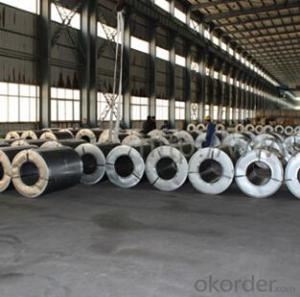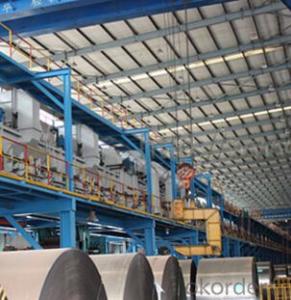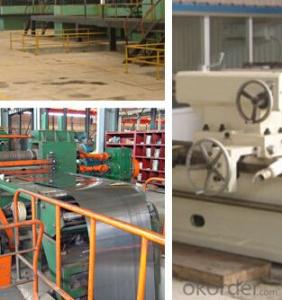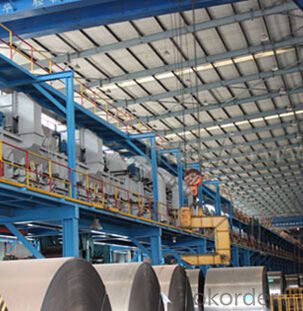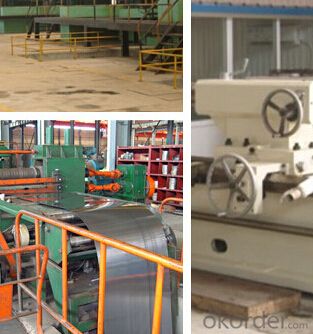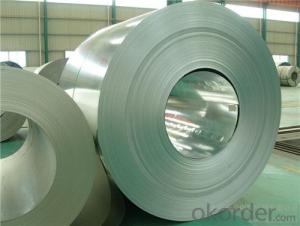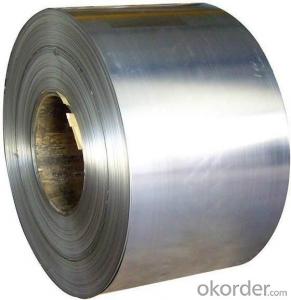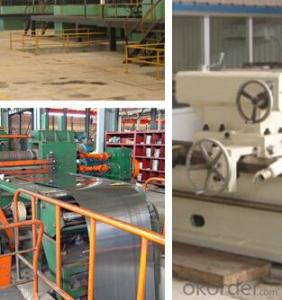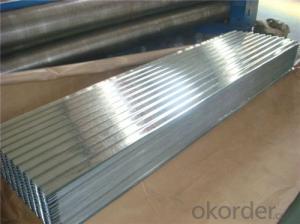Surface Finish Cold Rolled Steel Coil for Building
- Loading Port:
- Shanghai
- Payment Terms:
- TT OR LC
- Min Order Qty:
- 25 m.t.
- Supply Capability:
- 10000 m.t./month
OKorder Service Pledge
OKorder Financial Service
You Might Also Like
Basic Info.
Model NO.:SPCC
Surface Treatment:Oiled
Technique:Cold Rolled
Standard:ASTM, JIS, GB, DIN, BS
Steel Grade:SPCC
Product Description:Cold Rolled Steel
Brand Name:Cheeho & OEM
Heat Treatment:Annealed
Temper Type:Ba
Margin Status:Ec & Em
Surface Condition:Sb & SD
Surface Quality:FC & Fd
Inner Diameter:508-610mm
Approved Certificate:SGS & ISO & BV & TUV
Export Markets:Global
Additional Info.
Trademark:CheeHo & OEM
Packing:Standard Seaworthy Package
Standard:SGS & ISO & BV & TUV Approved
Origin:Jiangyin, Jiangsu, China
HS Code:72091790
Production Capacity:250000mt/Year
Product Description
Brief Introduction
Cold Rolled Steel is steel that has been worked below its recrystallization temperature by passing it between a pair of rollers. Recrystallization temperature is the temperature at which grains in the lattice structure of the metal have been rearranged, leaving it free of strain and deformations. Cold Rolled Steel is pre-treated before being cold rolled with a process known as pickling, which uses strong acids to remove scale and other impurities. The Cold Rolled Steel is then passed through rollers to reduce its thickness. Most cold rolling takes place in multiple passes and as the size of the Cold Rolled Steel is further reduced, its strength and hardness both increase, but its ductility decreases. After cold rolling, heating the metal up in a process known as annealing can restore some of its ductility. The final Cold Rolled Steel coil may be manufactured in the form of sheets, strips, bars, or other forms.
Specification
1. Thickness: 0.4-2.0mm
2. Width: 900-1250mm
3. Inner Diameter: 508mm
4. Weight of Steel Coil: 3-15MT
5. Heat Treatment: Annealed
6. Margin Status: EC & EM
7. Surface Quality: FB&FC
8. Surface Status: SB & SD
9. Surface Treatment: Oiling
Mechanical Properties
1. Yield Strength: ≤320MPa
2. Tensile Strength: ≤370MPa
3. Elongation (L=50mm, b=25mm) When:
(1) Nominal Thickness<0.25mm: 30%
(2) Nominal Thickness 0.25mm-<0.40: 32%
(3) Nominal Thickness 0.40-<0.60mm: 34%
(4) Nominal Thickness 0.60-<1.0mm: 36%
(5) Nominal Thickness 1.0-<1.6mm: 37%
(6) Nominal Thickness >1.6mm: 38%
Application
1. Base metal for coated and dipped products.
2. Home appliance
3. Precise welding tube
4. Flux cored welding wire
5. Bicycle, battery shell,
6. Automobile fitting, hardware
7. Enameling industry etc.
Superiority
1. High precision of dimensional tolerance
2. Excellent mechanical property such as the yield strength and tensile strength, etc.
3. Being highly resistant to denting
4. Exhibits useful magnetic properties
5. High quality surface finish and get well prepared for the surface coating
6. Available in a variety of sizes and shapes with characteristics useful in a wide range of applications
Chemical Components
| Grade | Chemical Components | ||||
| C | Mn | P | S | Alt | |
| SPCC | ≤0.12 | ≤0.50 | ≤0.035 | ≤0.025 | ≥0.020 |
| SPCD | ≤0.10 | ≤0.45 | ≤0.030 | ≤0.025 | ≥0.020 |
| SPCE | ≤0.08 | ≤0.40 | ≤0.025 | ≤0.020 | ≥0.020 |
- Q: How do steel coils contribute to sustainability efforts?
- Steel coils contribute to sustainability efforts in several ways. Firstly, steel is a highly recyclable material, and steel coils can be recycled and reused multiple times without losing their quality or strength. This reduces the demand for virgin steel production, which is an energy-intensive and environmentally damaging process. By incorporating recycled steel coils into manufacturing processes, companies can significantly reduce their carbon footprint and conserve natural resources. Additionally, steel coils have a long lifespan and are highly durable. This means that products made using steel coils, such as automotive parts, construction materials, or appliances, tend to have a longer lifespan as well. The longevity of these products reduces the need for frequent replacements, reducing waste generation and conserving resources. Furthermore, steel coils can be manufactured using advanced technologies that improve energy efficiency and reduce greenhouse gas emissions. Steel manufacturers are increasingly adopting more sustainable practices, such as using energy-efficient furnaces, optimizing production processes, and implementing recycling initiatives. These measures help minimize the environmental impact of steel production and contribute to overall sustainability efforts. Moreover, steel coils are often used in the construction industry, which plays a crucial role in sustainable development. Steel is a key component in the construction of energy-efficient buildings and infrastructure, such as green buildings and renewable energy projects. These structures are designed to minimize energy consumption, reduce emissions, and promote resource efficiency. By using steel coils in these sustainable construction projects, the industry can contribute to a greener and more sustainable future. In summary, steel coils contribute to sustainability efforts through their recyclability, durability, energy-efficient manufacturing processes, and their role in sustainable construction. By choosing steel coils and promoting their use, companies and industries can reduce their environmental impact, conserve resources, and help build a more sustainable society.
- Q: What are the challenges in coil slitting for narrow strip widths?
- The challenges in coil slitting for narrow strip widths include maintaining consistent tension throughout the process, minimizing edge burrs and camber, preventing material damage or deformation, and ensuring accurate width measurements and tolerances. Additionally, handling and feeding thin strips can be more difficult, as they are more prone to wrinkling, telescoping, or jamming during the slitting operation. Overall, achieving precision and high-quality results in coil slitting for narrow strip widths requires advanced equipment, expertise, and careful attention to detail.
- Q: Are steel coils resistant to rust and corrosion?
- Yes, steel coils are resistant to rust and corrosion. Steel coils are typically made from carbon steel or stainless steel, both of which have excellent corrosion resistance properties. Carbon steel coils are often coated with a protective layer, such as zinc or a polymer coating, to enhance their resistance to rust and corrosion. Stainless steel coils, on the other hand, are inherently corrosion-resistant due to the presence of chromium, which forms a protective oxide layer on the surface of the steel, preventing rust and corrosion. However, it is important to note that the level of resistance to rust and corrosion may also depend on the specific grade and quality of the steel used in the coils, as well as the environmental conditions they are exposed to.
- Q: Yes, I understand it can weaken steel greatly. But can it MELT steel? (key word: melt)
- Not likely -- the melting point of steel is about 1500 degrees Celsius, while the hottest jet fuel burns at is about 825 degrees Celsius (and its usually way below that). If you're one of those people wondering why the collapse in 9/11 ... it's quite possible that the temperatures and heat inside the buildings were way about the melting point of steel in some places. But it would not be just because of burning jet fuel. And, planes carry a lot of material that can catch fire at relatively low temperatures, but which can give off a huge amount of heat (and reach high temperatures), which would contribute to melting and burning of mild steel.
- Q: What are the different grades of steel coils?
- There are various grades of steel coils available, including low carbon steel, medium carbon steel, high carbon steel, stainless steel, and galvanized steel coils. Each grade has specific properties and applications, making them suitable for different industries and purposes.
- Q: But we've had a problem with bears being attracted to the water in the Intex Inflatable pools, the bear would come at night every so often and push on the sides letting out the water.Would a bear be able to bend a steel frame before I go and spend money?
- depends on the steel thickness and positioning. frm your question I'm guessing you're not really well versed in steel framing or use... im guessing whatever you build, a bear can destroy. if i was to build it not even 100 bears can destroy it. it doesn't require much steel, it's just about bracing the positing of steel and some design.
- Q: Hello... I'd like to know where I can find proof of this answer as well please. My own searching didn't come up with anything concrete.I'd like to know how much the ambient temperature inside of a hollow steel tube would rise by if the outside of that tube was exposed to an 1100 degree flame for a period of 3 seconds.If specifics help, they are something along the lines of 3.125 O.D. tube, 0.35 wall thickness. High grade steel, can't be more specific than that sorry.Thanks for any answers!
- I can asnswer this from practical experience. If the tube is sealed, temperature would rise approx. 25 deg F. If the tube were open the temperature would be less that a 10 deg F rise. The exact answer can be found in any book on thermodynamics.
- Q: What are the typical dimensions of a steel coil?
- The typical dimensions of a steel coil can vary depending on its specific application and industry. However, common dimensions for steel coils include a width ranging from 0.5 inches to 72 inches, and a thickness ranging from 0.010 inches to 0.625 inches. The inner diameter of the coil is usually between 16 inches and 24 inches, while the outer diameter can range from 48 inches to 72 inches.
- Q: What are the common problems faced during steel coil production?
- There are several common problems that can be encountered during steel coil production. One of the most common issues is coil breakage or damage. This can occur due to improper handling or transportation of the coils, which can lead to cracks or fractures. It is crucial to ensure proper handling procedures are followed to minimize the risk of coil breakage. Another common problem is coil slippage. This occurs when the coils are not securely stacked or stored, leading to them shifting or sliding. Coil slippage can result in damage to the coils and potentially cause accidents or injuries. Therefore, it is essential to have proper storage systems in place to prevent coil slippage. Additionally, coil corrosion is a common problem faced during steel coil production. Corrosion can occur due to exposure to moisture, air, or other corrosive substances. It can lead to the degradation of the steel, reducing its strength and durability. Implementing effective corrosion prevention measures, such as proper coating or storage techniques, is essential to mitigate this issue. Another challenge in steel coil production is coil quality issues. This can include inconsistent thickness, width, or surface defects on the coils. These quality problems can arise due to various factors, such as improper rolling processes, equipment malfunctions, or material defects. Regular quality checks and inspections should be conducted to identify and address any issues promptly. Moreover, coil handling and loading problems can also occur during steel coil production. Improper lifting or loading techniques can cause damage to the coils, leading to deformations or even accidents. It is crucial to train and educate employees on proper handling and loading procedures to prevent such problems. Overall, steel coil production can face various challenges, from coil breakage and slippage to corrosion and quality issues. Implementing proper handling, storage, and quality control measures is essential to minimize these problems and ensure the production of high-quality steel coils.
- Q: What are the common uses of coated steel coils?
- Coated steel coils are commonly used in various industries for applications such as automotive manufacturing, construction, and appliance production. These coils are utilized in the production of metal roofs, siding, garage doors, HVAC systems, and electrical appliances. The coating on the steel provides protection against corrosion, enhances durability, and improves aesthetics, making it an ideal choice for these applications.
Send your message to us
Surface Finish Cold Rolled Steel Coil for Building
- Loading Port:
- Shanghai
- Payment Terms:
- TT OR LC
- Min Order Qty:
- 25 m.t.
- Supply Capability:
- 10000 m.t./month
OKorder Service Pledge
OKorder Financial Service
Similar products
Hot products
Hot Searches
Related keywords
